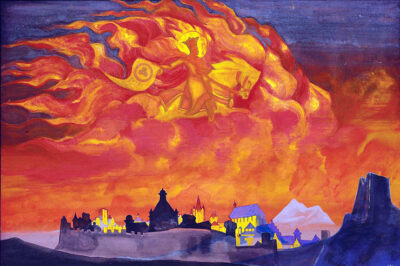From New Dawn Special Issue Vol 15 No 3 (July 2021)
‘Eurasia’ was not a name you heard in Australia thirty years ago. Apart from an obscure reference in academic publications focused on the Soviet Union, ‘Eurasia’ (Ezrasia) would occasionally be mentioned by emigres from the former Russian Empire who had made their way to Australia in the post-war period. Many of these Russians had lived for years in Harbin, Manchuria after fleeing the 1917 Bolshevik Revolution and resulting Russian Civil War.
My earliest recollection of ‘Eurasia’ was in a talk on the Russian artist Nicholas Roerich’s 1924-28 Central Asian expedition given to a meeting of the Melbourne-based Gnostic group the Order of the Pleroma. The speaker, an elderly gentleman who had corresponded with Professor Roerich in the 1940s, captivated his listeners with a vivid account of the Russian explorer’s extraordinary journey through Siberia, Mongolia, across the Gobi desert to Tibet and the scarcely known Trans-Himalayas. Covering vast unexplored regions of Eurasia, Roerich visited ancient monasteries, holding discussions with lamas, hermits and sages. He heard of ancient legends about the holy mountain, the planetary axis, and of the mysterious sacred land of Shambhala. Roerich immediately recognised how the vivid stories of Shambhala matched the Siberian myth of ‘Belovodye’ – the mystical ‘Golden Land’ also known as the ‘White Waters’.
While in Kashmir, Roerich’s encounter with long-forgotten wisdom inspired him to undertake a series of paintings dedicated to the Great Teachers of humanity – The Banners of the East. Roerich’s experiences led him to conclude that all cultures stem from a single source disseminated during the great migrations of people in distant historical times. This common source, he believed, should be searched for in Eurasia.
The Russian writer Maxim Gorky called Nicholas Roerich “the greatest intuitivist of modern life.” However, Roerich and his wife Elena always maintained they were directed in their undertakings by ‘Messengers of Wisdom’, the same mysterious personages who guided another Russian mystic, Madame H.P. Blavatsky, in the nineteenth century.
Prior to setting out in 1924 on their grand Central Asian expedition, the Roerich’s were instructed by their spiritual guide to launch the ‘Great Plan’, a Sacred Union of the East. A truly visionary geopolitical program, the Great Plan called for the union of Mongolia, Tibet, parts of India and China, with Siberia. This vast Eurasian Sacred Union was to have as its capital the equally visionary city of Zvenigorod that Roerich believed would appear in the Altai Mountains. While Roerich’s mystical Eurasian Sacred Union never materialised, his adventures in the service of this ‘utopian’ dream did capture the imagination of the world, drawing attention eastward to the great wonders of Central Asia.
According to historian John McCannon, “Aside from its breathtaking scope and fantastic nature, the most striking thing about the Great Plan is the way in which it wed political aspiration with esoteric belief… any attempt to understand Roerich’s political actions without taking into account his occult convictions…. is fruitless or inadequate.”
Nicholas Roerich was held in high regard by Russian emigres in Australia who were devoted to esoteric teachings. The writer Andrew Tomas, who was born in the Russian imperial city of St. Petersburg in 1906, considered Nicholas Roerich to be his Master. Tomas, who lived in China before settling in Australia in 1948 and becoming an Australian citizen, wrote of first meeting Roerich in Shanghai in 1935. The profound impact that Roerich had on Tomas is evident in two of his books published in the 1970s, Shambhala: Oasis of Light and Beyond the Time Barrier. Today, Tomas is remembered as a pioneering Australian UFO researcher, the author of popular paperbacks like We Are Not the First: Riddles of Ancient Science and On the Shores of Endless Worlds.
Fascinated by Nicholas Roerich’s journeys, I asked a Russian-Australian ‘old time’ esotericist for more information on Eurasia. He kindly gave me a book, A New Party in Russia by P. Malevsky-Malevitch, one of the first books about Eurasianism written in English way back in 1928. Nicholas Roerich was indeed inspired by a thoroughly Eurasian vision. One centred on the reconciliation of apparent opposites, the transcending of ideological differences, from which a new grand synthesis can emerge and a new day dawn for the peoples of earth, neither exclusively Western nor wholly Eastern, but truly Eurasian.
When in 1991 it was decided to publish a magazine that explored conspiracies, cover-ups and metaphysics, with a positive eye on the future, the title ‘New Dawn’ was suggested. Then those involved remembered Nicholas Roerich’s enigmatic statement, “The East has said that when the Banner of Shambhala encircles the world, verily the New Dawn will follow.” So, on the 1st May 1991, the first issue of New Dawn magazine appeared.
© New Dawn Magazine and the respective author.
For our reproduction notice, click here.


